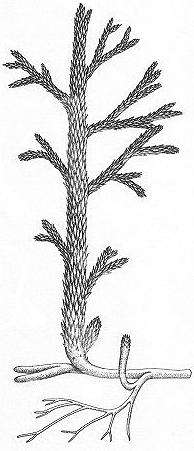Asteroxylon
Asteroxylon ("star-shaped xylem") is an extinct genus of vascular plants of the Division Lycopodiophyta known from anatomically preserved specimens described from the famous Early Devonian Rhynie chert and Windyfield chert in Aberdeenshire, Scotland.[1][2] Asteroxylon is considered the most basal member of the Lycopsida.[3]
| Asteroxylon | |
|---|---|
 | |
| Scientific classification | |
| Kingdom: | Plantae |
| Clade: | Tracheophytes |
| Clade: | Lycophytes |
| Class: | Lycopodiopsida |
| Order: | †Drepanophycales |
| Family: | †Asteroxylaceae Kidston & Lang |
| Genus: | †Asteroxylon Kidston & Lang 1920 |
| Type species | |
| Asteroxylon mackiei Kidston & Lang | |
Description
Asteroxylon is a genus of terrestrial vascular plant which flourished in the Early Devonian period. This plant consisted of aerial, isotomously and anisotomously branching stems that reached 12 mm in diameter and 40 cm in length.[4] The possibly procumbent aerial stems arose from a leaf-less rhizome which bore smaller-diameter, positively geotropic root-like branches.[4] The rhizomes, which represent an independent origin of roots,[5] reached a depth of up to 20 cm below the surface.[6] The xylem or conducting tissue at the center of the aerial stems is distinctly star-shaped in cross-section and has been considered an early actinostele or an "Asteroxylon-type" protostele.[7] The tracheids are of the primitive annular or helical type (so-called G-type).[8] "Leaves" – not true leaves, but protrusions – were of the form of unbranched strap-shaped enations up to 5 mm long; a single vascular trace branched from the main bundle in the centre of the stem to terminate at the base of each enation.[3][7] Enations and axes bore stomata, indicating that their tissues were capable of photosynthesis.[9]
"Sporangia, consisting of two kidney-shaped valves, are interspersed among the nonvascularized leaflike appendages and attached to the axis with a short pedicel. The sporangia are curved and lie close to the axis."[7][10] Fertile regions of the axes alternate with sterile regions, suggesting periodic episodes of fertility.[7]
Asteroxylon differs from other similar Early Devonian lycopsids such as Drepanophycus and Baragwanathia in that the singular vascular leaf trace in these latter plants extends into the leaf.[3] The leaves of Drepanophycus and Baragwanathia are therefore considered to be true microphylls or, alternatively, small leaves.[11]
Species
The type species is Asteroxylon mackiei. One other species has been described, Asteroxylon elberfeldense,[12] but this is now considered to be generically distinct and assigned to Thursophyton.[8] A fossil originally named as Asteroxylon setchellii is now considered to be a fern, and is known as Stenokoleos setchellii.
References
- Kidston, R.; Lang, W. H. (1920). "On Old Red Sandstone Plants showing Structure, from the Rhynie Chert Bed, Aberdeenshire. Part III. Asteroxylon Mackiei, Kidston and Lang". Transactions of the Royal Society of Edinburgh. 52 (3): 643–680. doi:10.1017/S0080456800004506.
- Rice, C. M.; Ashcroft, W. A.; Batten, D. J.; Boyce, A. J.; Caulfield, J. B. D.; Fallick, A. E.; Hole, M. J.; Jones, E.; Pearson, M. J.; Rogers, G.; Saxton, J. M.; Stuart, F. M.; Trewin, N. H.; Turner, G.; et al. (1995). "A Devonian auriferous hot spring system, Rhynie, Scotland". Journal of the Geological Society, London. 152 (2): 229–250. doi:10.1144/gsjgs.152.2.0229.
- Hao, Shougang; Xue, Jinzhuang (2013). The Early Devonian Posongchong Flora of Yunnan - A Contribution to an Understanding of the Evolution and Early Diversification of Vascular Plants. Beijing: Science Press. pp. 244–245. ISBN 978-7-03-036616-0.
- Strullu‐Derrien, Christine; Wawrzyniak, Zuzanna; Goral, Tomasz; Kenrick, Paul (2015). "Fungal colonization of the rooting system of the early land plant Asteroxylon mackiei from the 407‐Myr‐old Rhynie Chert (Scotland, UK)". Botanical Journal of the Linnean Society. 179 (1): 201–213. doi:10.1111/boj.12307.
- Hetherington, Alexander J.; Dolan, Liam (2018). "Stepwise and independent origins of roots among land plants". Nature. 561 (7722): 235–238. doi:10.1038/s41586-018-0445-z. PMC 6175059. PMID 30135586.
- Smoot, E.L.; Jansen, R.K.; Taylor, T.N. (1981). "A Phylogenetic Analysis of the Land Plants: A Botanical Commentary". Taxon. 30 (1): 65–67. doi:10.2307/1219392. JSTOR 1219392.
- Kerp, Hans; Wellman, Charles H.; Krings, Michael; Kearney, Patricia; Hass, Hagen (2013). "Reproductive organs and in situ spores of Asteroxylon mackiei Kidston & Lang, the most complex plant from the lower Devonian Rhynie chert". International Journal of Plant Sciences. 174 (3): 293–308. doi:10.1086/668613.
- Kenrick, Paul & Crane, Peter R. (1997). The Origin and Early Diversification of Land Plants: A Cladistic Study. Washington, D.C.: Smithsonian Institution Press. ISBN 978-1-56098-730-7.
- Wilson, Jonathon P.; Fischer, Woodward W. (2011). "Hydraulics of Asteroxylon mackei, an early Devonian vascular plant, and the early evolution of water transport tissue in terrestrial plants". Geobiology. 9 (2): 121–130. doi:10.1111/j.1472-4669.2010.00269.x. PMID 21244621.
- In their original description, Kidston & Lang thought that some unconnected sporangial branches, similar to those of rhyniophytoids, possibly belonged to Asteroxylon, and in spite of the lack of certainty, many subsequent authors constructed suprageneric taxonomies based on this assumption. The true nature of Asteroxylon sporangia, and of these unconnected sporangia (which were found to belong to Nothia aphylla) were later shown by: Lyon, A.G. (1964). "Probable Fertile Region of Asteroxylon mackiei K. and L.". Nature. 203 (4949): 1082–1083. doi:10.1038/2031082b0..
- Tomescu, Alexandru M.F. (2009). "Megaphylls, microphylls and the evolution of leaf development". Trends in Plant Science. 14 (1): 5–12. doi:10.1016/j.tplants.2008.10.008. PMID 19070531.
- Fairon, M. (1967). "Asteroxylon elberfeldense Kräusel et Weyland porte-t-il des axes terminaux du type Hostimella hostimensis Potonié et Bernard". Annales de la Société Géologique de Belgique. 10: 1–30.